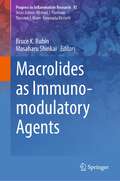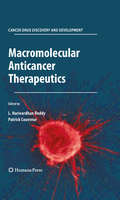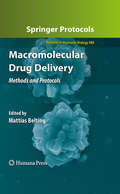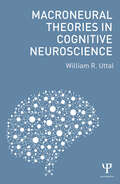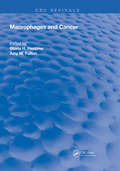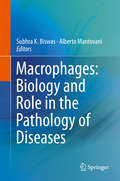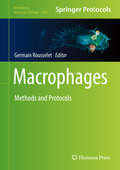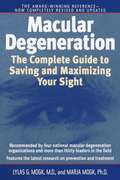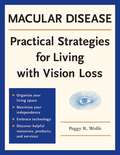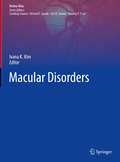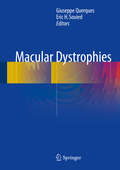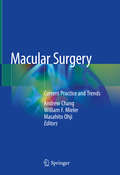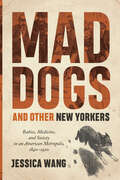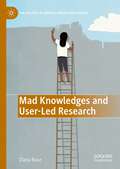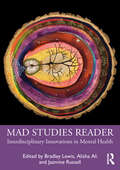- Table View
- List View
Macro-Glycoligands
by Xue-Long SunThis volume details methods and protocols for the synthesis and characterization of glycopolymers and their biomedical applications. Chapters are divided into three parts covering synthesis and characterization of glycopolymers; glycopolymer-nanoparticle conjugates; and surface immobilized glycopolymers. Written for the Methods in Molecular Biology series, chapters include introductions to their respective topics, lists of the necessary materials and reagents, step-by-step, readily reproducible laboratory protocols, and tips on troubleshooting and avoiding known pitfalls. Authoritative and practical, Macro-Glycoligands: Methods and Protocols aims to ensure successful results in the further study of this vital field.
Macrolides as Immunomodulatory Agents (Progress in Inflammation Research #92)
by Bruce K. Rubin Masaharu ShinkaiFor over 50 years, clinicians have known that macrolide antibiotics have effects on inflammation and the immune system that are not related to their antimicrobial properties. These immunomodulatory properties, best described for treating inflammatory airway diseases, protect the lung and the host and improve clinical status. This book summarizes our current knowledge regarding proposed mechanisms for these properties, established clinical results, and what the future may hold with emphasis on novel clinical applications and the fascinating development of non-antimicrobial macrolides with preserved and enhanced immunomodulatory properties.
Macromolecular Anticancer Therapeutics
by Patrick Couvreur L. Harivardhan ReddyIn spite of the development of various anticancer drugs, the therapy of cancer has remained challenging for decades. The current therapy of cancer is overwhelmed because of the inability to deliver therapeutics to all regions of a tumor in effective therapeutic concentrations, intrinsic or acquired resistance to the treatment with currently available agents via genetic and epigenetic mechanisms, and toxicity. As a result, cancer therapy using conventional therapeutics and different types of treatment regimens using this therapeutics has not led to a convincing survival benefit of the patients. In this context, Macromolecular therapeutics offer several advantages over conventional low molecular therapeutics by various ways such as, enable the use of larger doses of these agents by limiting the toxicity, by enhanced permeability and retention into tumors, by tumor targeting using tumor-specific antibodies, by specific inhibition of oncogenes using anticancer oligonucleotides etc. Cancer treatment using this macromolecular therapeutics has considerably improved the survival benefit for patients. As a result, various macromolecular therapeutics are already commercialized or are under clinical development. Although we are far from a real magic bullet today, looking at the pace of research and current success in this field of macromolecular therapeutics, it appears that we are approaching a magic bullet for the efficient treatment of cancer. Thus, we believe that the subject of this book is very timely, and that the book will fill an unmet need in the market. This book is unique and assembles various types and aspects of macromolecular anticancer therapeutics for cancer therapy in one shell and conveys the importance of this interdisciplinary field to the broad audience. Thus, in a nutshell, this book details the basics of cancer, and various therapeutic strategies such as those based on macromolecular therapeutics hence can become an important reference for practitioners, oncologists, medical pharmacologists, medicinal chemists, biomedical scientists, experimental pharmacologists, pharmaceutical technologists, and particularly it can essentially become a handbook of macromolecular therapeutics for cancer therapy for graduates, post-graduates and Ph.D. students in these fields.
Macromolecular Drug Delivery
by Mattias BeltingMacromolecular drugs hold the promise of becoming new therapeutics for several major disorders, including cancer and cardiovascular disease. This incredible potential is explored in Macromolecular Drug Delivery, a volume which gives a wide-ranging overview of contemporary methods used in the field, and which addresses the limitations presented by a lack of safe and efficient drug delivery strategies. Chapters offer information on both in vitro and in vivo methods of macromolecular delivery, thus appealing to a broad scientific audience. Composed in the highly successful Methods in Molecular BiologyTM series format, each chapter contains a brief introduction, step-by-step methods, a list of necessary materials, and a Notes section which shares tips on troubleshooting and avoiding known pitfalls. Comprehensive and cutting-edge, Macromolecular Drug Delivery offers a platform for interdisciplinary collaboration, which should provide opportunities for new discoveries at the interface between disciplines. Ultimately, this cooperation will lead to the use of macromolecular drugs as novel diagnostic tools and, even more importantly, as a means to revolutionize the way we view and treat diseases.
Macroneural Theories in Cognitive Neuroscience
by William R. UttalIn this book, William R. Uttal continues his analysis and critique of theories of mind. This book considers theories that are based on macroneural responses (such as those obtained from fMRI) that represent the averaged or cumulative responses of many neurons. The analysis is carried out with special emphasis on the logical and conceptual difficulties in developing a theory but with special attention to some of the current attempts to go from these cumulative responses to explanations of the grand question of how the mind is generated by the brain. While acknowledging the importance of these macroneural techniques in the study of the anatomy and physiology of the brain, Uttal concludes that this macroneural approach is not likely to produce a valid neural theory of cognition because the critical information—the states of the individual neurons—involved in brain activity becoming mental activity is actually lost in the process of summation. Controversial topics are considered in detail including discussions of empirical, logical, and technological barriers to theory building in cognitive neuroscience.
Macrophage Migration Inhibitory Factor: Methods and Protocols (Methods in Molecular Biology #2080)
by James Harris Eric F. MorandThis volume looks at--and discusses the techniques of--a range of areas in biology in which macrophage migration inhibitory factor (MIF) is studied. Topics covered in this book include methods to quantify MIF in cell supernatants and human samples, using ELISA and western blot; detection and analysis of intracellular MIF using flow cytometry; genotyping of human MIF polymorphisms, detection of MIF expression in a marine invertebrate using rapid amplification of cDNA RACE; studying the MIF receptor CD74 in tissues using immunohistochemistry; and studying MIF in models of disease such as asthma, Plasmodium infection, and gout. Written in the highly successful Methods in Molecular Biology series format, chapters include introductions to their respective topics, lists of the necessary materials and reagents, step-by-step, readily reproducible laboratory protocols, and tips on troubleshooting and avoiding known pitfalls. Comprehensive and practical, Macrophage Migration Inhibitory Factor: Methods and Protocols is a valuable resource that will help researchers gain a new understanding of MIF biology in health and disease.
Macrophage Targeted Delivery Systems: Basic Concepts and Therapeutic Applications
by Yashwant V. Pathak Swati GuptaThe proposed book is envisioned for the nascent and entry-level researchers who are interested to work in the field of drug delivery and its applications specifically for macrophage targeting. Macrophages have gained substantial attention as therapeutic targets for drug delivery considering their major role in health and regulation of diseases. Macrophage-targeted therapeutics have now added significant value to the lives and quality of life of patients, without undue adverse effects in multiple disease settings. We anticipate examining and integrating the role of macrophages in the instigation and advancement of various diseases. The major focus of the book is on recent advancements in various targeting strategies using delivery systems or nanocarriers followed by application of these nanocarriers for the treatment of macrophage associated disorders. Macrophage Targeted Delivery Systems is primarily targeted to Pharmaceutical Industry & Academia, Medical & Pharmaceutical Professionals, Undergraduate & Post graduate students and Research Scholars, Ph.D, post docs working in the field of medical and pharmaceutical sciences.
Macrophages & Cancer (Routledge Revivals)
by Amy M. Fulton Gloria H. HeppnerFirst Published in 1988, this book offers a full, comprehensive guide into the relationship between macrophages and Cancer. Carefully compiled and filled with a vast repertoire of notes and references this book serves as a useful reference for Students of Medicine, Oncology and other practitioners in their respective fields.
Macrophages and Dendritic Cells
by Neil E. ReinerIn light of the critical contributions of macrophages and dendritic cells to diverse inflammatory diseases and to immunity and host defense, state-of-the-art approaches to the investigation of their behavior are essential. In Macrophages and Dendritic Cells: Methods and Protocols, expert researchers contribute laboratory protocols involving these two vital cell types functioning at the junction of the innate and acquired immune systems. The volume delves first into isolation and cell culturing then continues with topics such as phagocytosis, genetic manipulation, macrophage activation, and lipid signaling. Written in the highly successful Methods in Molecular BiologyTM series format, chapters include brief introductions to their respective subjects, lists of the necessary materials and reagents, step-by-step, readily reproducible protocols, and notes on troubleshooting and avoiding known pitfalls. Authoritative and cutting-edge, Macrophages and Dendritic Cells: Methods and Protocols provides a timely and useful guide for both seasoned investigators and neophytes pursuing this imperative field of study.
Macrophages: Biology and Role in the Pathology of Diseases
by Subhra K. Biswas Alberto MantovaniMacrophages are a key component of the innate immune system and play an integral role in host defense and homeostasis. On one hand, these cells contribute to host defence by triggering inflammation, displaying microbicidal/tumoricidal properties, regulating the activation of adaptive immunity and promoting resolution of inflammation. On the other hand, they contribute to essential trophic functions such as neural patterning, bone morphogenesis and ductal branching in mammary glands. Thus, macrophages are extremely versatile cells that can respond efficiently to tissue micro environmental cues by polarizing to distinct phenotypes, depending on the functions they need to perform. Indeed, functional diversity and plasticity are hallmarks of these cells. Macrophages may also play a detrimental role. An overwhelming body of literature has indicated their crucial role in pathogenesis. The list includes sepsis, cancer, metabolic syndrome, immunodeficiency, auto-immune disease-virtually impacting every major pathology that we know. These observations have suggested macrophages and their related molecules as potential targets in therapeutic applications. Available evidence proclaims macrophages as a key player in homeostasis, host defense and disease. Crucial developments in the past few years call for a re-evaluation and update of our understanding of macrophages. The present book is an endeavour that attempts provide state-of-the art knowledge of these cells in health and disease.
Macrophages: Methods And Protocols (Methods in Molecular Biology #1784)
by Germain RousseletThis volume discusses basic and advanced techniques to study macrophages and their unique properties. The chapters in this book cover numerous topics such as in vitro culture models for murine and human macrophages; isolation of resident macrophages from several tissues; functional analyses of macrophages; and transgenic models of macrophage depletion and macrophage targeting. Written in the highly successful Methods in Molecular Biology series format, chapters include introductions to their respective topics, lists of the necessary materials and reagents, step-by-step, readily reproducible laboratory protocols, and tips on troubleshooting and avoiding known pitfalls.Cutting-edge and comprehensive, Macrophages: Methods and Protocols is a valuable resource for researchers who are interested in studying macrophages on an experimental level.The chapters A Simple Multi-Step Protocol for Differentiating Human Induced Pluripotent Stem Cells into Functional Macrophages and Isolation and Phenotyping of Adult Mouse Microglial Cells are open access under a CC BY 4.0 license via link.springer.com.
Macropinocytosis: Functions and Mechanisms (Subcellular Biochemistry #98)
by Cosimo CommissoThis book presents the functions and mechanisms of macropinocytosis, an actin-driven endocytic uptake process.Key points, including the evolutionary origins of macropinocytosis and major signaling pathways that regulate this uptake mechanism, are highlighted. A wide-array of functions of macropinocytosis are described, including cellular metabolism, cell death, cell migration and antigen presentation. Macropinocytosis has recently been recognized as a critical pathway in disease pathology and treatment. Therefore, a broad overview of macropinocytosis will benefit clinicians, as well as translational and basic research scientists. Moreover, as one of the main clathrin-independent endocytic routes, compiling all the critical information about macropinocytosis in one collection, this book will also be helpful to educators and their students.
Macroporous Polymers: Production Properties and Biotechnological/Biomedical Applications
by Ashok Kumar Bo Mattiasson Igor Yu. GalaevMacroporous polymers are rapidly becoming the material of choice for many tissue engineering, bioseparation, and bioprocessing applications. However, while important information is scattered about in many different publications, none, to date, have drawn this information together in user-friendly format, until now. Meeting the need for an accessibl
Macular Degeneration: The Complete Guide to Saving and Maximizing Your Sight
by Lylas G. Mogk Marja MogkDr. Lylas Mogk has a unique personal and professional understanding of AMD. This book explains how to successfully manage and limit its effect on a person's life.
Macular Disease: Practical Strategies for Living with Vision Loss
by Peggy R. WolfeThis invaluable guide to living well with vision loss is the perfect blend of abundant factual material and real-life experience. The book's positive, take-charge approach offers reassurance, hope, and hundreds of proven techniques, strategies, and tips for both the newly diagnosed and those at later stages of their disease. "My Story" vignettes in each chapter describe the author's fears, foibles, and triumphs in challenging situations. Readers will identify with the author's experiences and be encouraged by knowing she successfully traveled the same path.
Macular Disorders (Retina Atlas)
by Ivana K. KimThis atlas presents chapters on common and rare macular diseases including variants of age-related macular degeneration (dry, neovascular, polypoidal choroidal vasculopathy), cystoid macular edema, macular telangiectasia, central serous retinopathy and pachychoroid disease, photic retinopathy, presumed ocular histoplasmosis syndrome, myopic degeneration, angioid streaks, and a recently described entity: perifoveal exudative vascular anomalous complex. It provides a wealth of representative images, using various modalities to help the reader recognize the respective conditions. Importantly, it also includes images acquired using techniques more recently adopted in clinical practice such as autofluoresence, optical coherence tomography (OCT), and OCT angiography. The concise text reviews the basic concepts of etiology, diagnosis, and management in a highly accessible format. In contributions prepared by internationally respected experts, the atlas provides a cutting-edge analysis of each condition, as well as excellent summaries of recent work in the field. Macular Disorders is one of nine volumes in the series Retina Atlas. The series offers a global perspective on vitreoretinal diseases, covering imaging basics, retinal vascular disease, ocular inflammatory disease, retinal degeneration, surgical retina, macular disorders, ocular oncology, pediatric retina and trauma. In nine volumes and over 100 chapters, Retina Atlas offers comprehensive and validated information on retinal disorders.
Macular Dystrophies
by Giuseppe Querques Eric H. SouiedThis book provides the ophthalmologist with the most recently available data on the macular dystrophies, a group of many different inherited or sporadic eye conditions linked by a problem with photoreceptors or other structures of the central retina. Internationally recognized experts in the field present the latest evidence and discuss their own personal experiences with regard to each of the principal dystrophies as well as some very rare entities. Topics covered include molecular biology, state-of-the-art diagnostic techniques, and the newest treatment options, including still experimental therapies. Attention is also devoted to a range of issues that continue to be debated. The editors have taken care to ensure that chapters are of a uniformly high standard while not sacrificing the originality of the individual authors. Macular Dystrophies will fully acquaint the reader with both the latest research findings and the current and emerging approaches to diagnosis and treatment.
Macular Surgery: A Clinical Guide
by Fabio Patelli Stanislao Rizzo Carl AwhThis book provides a practical guide to techniques for recurrent macular hole and the application of new devices for macular surgery. Newer and more sophisticated optical coherence tomography (OCT) instruments are described in detail which allow the surgeon to better understand the anatomy of the retina before and after surgery. New forceps and intraoperative OCT that gives immediate visualisation during surgery and permits better surgical outcomes are also highlighted in the book. Macular Surgery: A Clinical Guide will be an essential resource for all ophthalmic surgeons seeking an informative and easy-to-follow clinical guide for routine and difficult cases.
Macular Surgery: Current Practice and Trends
by Andrew Chang Masahito Ohji William F. MielerRecent technological advances in the diagnosis of macular disorders have enhanced our understanding of these diseases. At the same time, advances in small-gauge vitrectomy instrumentation and techniques have improved the safety and efficiency of surgery, allowing macular conditions that would have otherwise resulted in blindness to be treated effectively, preserving patients’ sight. Macular surgery continues to evolve rapidly, thanks to exciting future technology trends. This book provides a detailed and up-to-date overview of the field. It begins with essential information on macular anatomy and pathophysiology, examination techniques, and surgical instrumentation. In turn, it discusses a broad range of disease processes, including macular holes, epiretinal membrane, vitreomacular traction and myopic maculopathy. The role and benefits of advanced vitrectomy techniques including submacular surgery, prosthetic vision, robotic surgery, and stem cell and gene therapy are addressed in detail. A review of perioperative care and potential complications rounds out the coverage.
Mad Cow Crisis: Health And The Public Good
by Scott C. RatzanThe announcement that BOSER might cause a fatal human disease "Creutzfeldt- Jacob disease CJD" triggered enormous media attention, public alarm and government wrangling that threatened the future of European integration.; As Scott Ratzan argues: "It is my belief that the [BOSER crisis] represents a quintessential case that will go down in history as the Exxon Valdez Union Carbide's Bhopal accident, and other such cases of interdisciplinary study".; This book offers lessons learned from the crisis, with contributions from experts with different viewpoints - veterinarians, Eurocrats, public relations experts, politicians, policy- makers, journalists and representatives of the beef industry.; It also offers a compilation of the key reports from governmental bodies. as a case-study in policy-making, scientific/health discovery and dissemination of information, as well as looking at the issues from the perspective of psychology and media studies.
Mad Dogs and Other New Yorkers: Rabies, Medicine, and Society in an American Metropolis, 1840–1920 (Animals, History, Culture)
by Jessica WangHow rabid dogs, the struggles to contain them, and their power over the public imagination intersected with New York City's rise to urban preeminence.Rabies enjoys a fearsome and lurid reputation. Throughout the decades of spiraling growth that defined New York City from the 1840s to the 1910s, the bone-chilling cry of "Mad dog!" possessed the power to upend the ordinary routines and rhythms of urban life. In Mad Dogs and Other New Yorkers, Jessica Wang examines the history of this rare but dreaded affliction during a time of rapid urbanization. Focusing on a transformative era in medicine, politics, and urban society, Wang uses rabies to survey urban social geography, the place of domesticated animals in the nineteenth-century city, and the world of American medicine. Rabies, she demonstrates, provides an ideal vehicle for exploring physicians' ideas about therapeutics, disease pathology, and the body as well as the global flows of knowledge and therapeutics. Beyond the medical realm, the disease also illuminates the cultural fears and political contestations that evolved in lockstep with New York City's burgeoning cityscape.Mad Dogs and Other New Yorkers offers lay readers and specialists alike the opportunity to contemplate a tumultuous domain of people, animals, and disease against a backdrop of urban growth, medical advancement, and social upheaval. The result is a probing history of medicine that details the social world of New York physicians, their ideas about a rare and perplexing disorder, and the struggles of an ever-changing, ever-challenging urban society.
Mad Knowledges and User-Led Research (The Politics of Mental Health and Illness)
by Diana Susan RoseThis book presents a critical examination of the development of user involvement within research, and investigates the issues currently preventing a productive integration of Mad knowledges within research and practice. Drawing on social, linguistic and critical theories, it proposes the conditions needed to address the development of Mad epistemologies. The author’s unique approach deliberately highlights her own positionality and draws on decades of experience as a service recipient, survivor, activist and researcher to illustrate the structural and symbolic barriers faced. Employing concepts including epistemic injustice, individualization, normalization and structural violence, it suggests a radically new way of articulating ‘what’s the matter with us?’ In doing so, the book itself goes some way towards enacting the radical challenge to academic and epistemic hierarchies which, it is argued, will be required to further advance mad knowledges and user-led research. Crucially, it demonstrates how this approach can be both methodologically and conceptually rigorous. This novel work holds important insights for students and scholars across the humanities and social sciences; particularly those working in the areas of critical psychology, disability studies, Mad studies, feminist studies, critical race theory, and Queer theory.
Mad Science: Psychiatric Coercion, Diagnosis, and Drugs
by Stuart A. Kirk*Winner of an honorable mention from theSociety for Social Work and ResearchforOutstanding Social Work Book AwardMad Science argues that the fundamental claims of modern American psychiatry are based on misconceived, flawed, and distorted science. The authors address multiple paradoxes in American mental health research, including the remaking of coercion into scientific psychiatric treatment, the adoption of an unscientific diagnostic system that controls the distribution of services, and how drug treatments have failed to improve the mental health outcome.When it comes to understanding and treating mental illness, distortions of research are not rare, misinterpretation of data is not isolated, and bogus claims of success are not voiced by isolated researchers seeking aggrandizement. This book's detailed analysis of coercion and community treatment, diagnosis, and psychopharmacology reveals that these characteristics are endemic, institutional, and protected in psychiatry. They are not just bad science, but mad science.This book provides an engaging and readable scientific and social critique of current mental health practices. The authors are scholars, researchers, and clinicians who have written extensively about community care, diagnosis, and psychoactive drugs. This paperback edition makes Mad Science accessible to all specialists in the field as well as to the informed public.
Mad Studies Reader: Interdisciplinary Innovations in Mental Health
by Bradley Lewis, Alisha Ali and Jazmine RussellThe last few years have brought increased writings from activists, artists, scholars, and concerned clinicians that cast a critical and constructive eye on psychiatry, mental health care, and the cultural relations of mental difference. With particular focus on accounts of lived experience and readings that cover issues of epistemic and social injustice in mental health discourse, the Mad Studies Reader brings together voices that advance anti-sanist approaches to scholarship, practice, art, and activism in this realm.Beyond offering a theoretical and historical overview of mad studies, this Reader draws on the perspectives, voices, and experiences of artists, mad pride activists, humanities and social science scholars, and critical clinicians to explore the complexity of mental life and mental difference. Voices from these groups confront and challenge standard approaches to mental difference. They advance new structures of meaning and practice that are inclusive of those who have been systematically subjugated and promote anti-sanist approaches to counter inequalities, prejudices, and discrimination. Confronting modes of psychological oppression and the power of a few to interpret and define difference for so many, the Mad Studies Reader asks the critical question of how these approaches may be reconsidered, resisted, and reclaimed.This collection will be of interest to mental health clinicians; students and scholars of the arts, humanities and social sciences; and anyone who has been affected by mental difference, directly or indirectly, who is curious to explore new perspectives.
Mad Studies: The Basics (The Basics)
by Merrick Daniel PillingMad Studies: The Basics provides an introductory account of a field that emerged from, and must remain grounded within, community knowledge, activism, and the perspectives of those who have experienced madness and mental health systems.It is a concise text that introduces the field through an exploration of some origins of Mad Studies, as well as two interrelated queries: what does Mad Studies help us understand, and what does Mad Studies help us do? This exploration reveals that Mad Studies is an interdisciplinary, intersectional, and multi-vocal field that demands different answers to the very meaning of the beliefs, behaviours, and bodymind experiences that are currently characterized as being indicative of mental illness. At the heart of Mad Studies is a liberationist desire to resist, transform, and abolish the systems that create marginalization, and implement responses to madness that are grounded in the collective knowledge of those deemed Mad. This book shows that the contributions of Indigenous, Black, racialized, queer, and trans people must be understood as central to, and already embedded within, Mad Studies and activism rather than as add-ons, expansions, or efforts to make Mad Studies more inclusive.It will be of interest to all scholars and students of disability studies, social work, gender studies, education, health sciences, sociology, and psychology, as well as practitioners in mental health care, and those with lived experience of madness and mental health systems.

